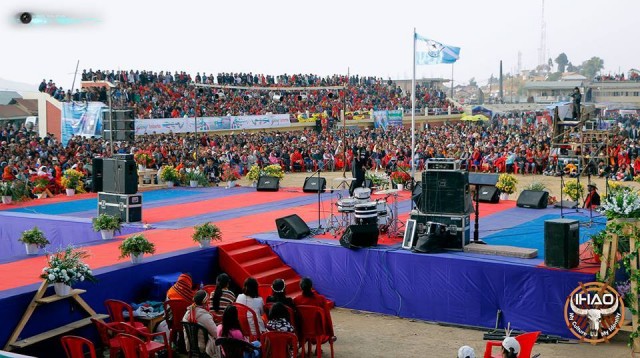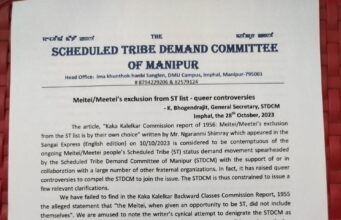By Aheibam Koireng Singh
A representation submitted to the Manipur Chief Minister for reinstating ‘Gaan Ngai’ as State Holiday by Zeliangrong Union Clubs Association Manipur Valley (ZUCAMV) on 31-10-2002 allegedly stated ‘Lui-Ngai-Ni’ as artificial state sponsored festival”. The declaration of ‘Lui-Ngai-Ni’ as state general holiday during the Chief Minstership of Rishang Keishing in 1988, himself from Tangkhul community and his remaining in active politics as senior most Congress leader at the time of dropping Gaan Ngai from the holiday list perhaps prompted ZUCAMV to make such statement.
The endeavor for the invention of common festival of the ‘Nagas’ in Manipur started in the mid 1980s. Nagas being the most colorful people have been characterized by diversity. Some who now identify themselves as Nagas were classified by the earlier British colonial administrator as belonging to the Chin-Kuki-Mizo (CHIKIM). If that is the case then can we say whether ‘Naga’ is more of a political creed than a socio-cultural identity.
Hobsbawn and et.al says (rp., 2002) ‘traditions’ which appear or claimed to be old are often quite recent in its origin and sometimes invented. This contention seems equally valid in the case of Lui-ngai-ni. An introductory statement by Secretary, Organising Committee, in the Souvenir, Naga Lui-Ngai-Ni, the 15th February, 1988, Imphal says: “of late, the Naga groups have emerged from their isolated doll-states and asserted their identity as one race in the comity of the Indian Nation which has been accepted by the Government of India. …
The Nagas do not have a common festival which could be called as the “national festival.” This statement reflects the quest for concretizing the identity of the Manipur Nagas, which they perhaps felt it inevitably necessary to satisfy the political needs of the present generation.
Considering the need for a common festival of their own, Naga scholars, leaders and social workers considered to organize a seminar, to find out ways and means whereby a common festival of the Nagas could be formulated. Proceedings of the Seminar on the ‘Manipur Naga festivals’ held on 10th of May, 1986 at GM. Hall, Imphal resolved that the Nagas in Manipur should have a common festival day in a year. Names suggested in the Recommendation Committee of the seminar are:
o Naga Seedling Day
o Naga Cultural Awakening/Revival Day
o Naga Festival Day
o Naga Farmer’s Day
o Naga Seed Day
o Naga New Year
o Naga Seed Sowing Festival and so forth
The members recommended Naga Seed Sowing festival which is to be observed in the 15th of February every year as the most appropriate and decided to forward it to the state government for necessary implementation. Naga Seed Sowing Festival was observed for the first time in 15th February 1987 with an appeal to ‘every sane Naga’ to play their part to make it a permanent Naga festival for years to come for “a race without its own culture is a lost race beyond redemption”.(Lui-Ngai-Ni Souvenir, 1988).
The follow up seminars and consultations in the aftermath of the festival decided that “the function shall hitherto be called Naga Lui-Ngai-Ni”. Lui-Ngai-Ni festival also has now been listed as one of the tourist festivals of India by the Ministry of Tourism, GoI. The nomenclature “Lui-Ngai-Ni” was coined by amalgamating the initials ‘Lui’ from the Tangkhul New Year festival, ‘Luira’; ‘Ngai’ from the Rongmei festival ‘Gaan Ngai’ with ‘Ni’ from the ending of the MaoMaram/Poumai festival, ‘Chithuni’.
The biggest and first festival of Tangkhuls in a calendar year, ‘Luira’ which falls in February is a festival to commemorate the first seed sowing of crops, and is celebrated with dancing, singing and feasting in their best colorful costumes. Most interesting highlights of this festival are
– 1. Thingreira-Khangakun (Tug of war); and
2. Lakhaaganui (virgin dance/ beauty contest).
People who had gone out from the village would certainly come back home in time to participate in ‘Thingreira-Khangakun’. When the whole village, men and women, young and old, have all come to participate in it, they hold the rope and sing a song, the meaning of which is, ‘ring out the old, ring in the new with all the blessing and bountiful harvest’.’
Gaan-Ngai is the festival of the Zeliangrong which is also described as a New Year Festival. ‘Gaan-Ngai’ is also called ‘Hegangi’ among the ‘Zeme’ and ‘Gin-Ngi’ among the Liangmei. Gaan-Ngai performs the production of fire, ‘Mairapmei’. It was usually performed between the month of October and December depending on the state of the progress of agricultural operation.
Later, the Kabui Naga Association, the progenitor of the present Zeliangrong Union decided in 1947 that Gaan-Ngai be performed on the 13th day of the Meitei month of ‘Wakching’ a month which usually falls in the month of January as per the Meitei calendar of the lunar year. Since then, it has been performed on 13th of ‘Wakching’ onwards.
‘Chithuni’ is the biggest and most important festival among the Mao tribes of Manipur. It falls in the month of January (Chithunikhro). It is generally celebrated for five days at a stretch, but some villages continue up to the sixth day even. However the festive season extends upto ‘Onianu’, fifteen days later. The festival in accordance with the significances attached to it can also be called as the festival of: the Harvesting; the New Year; and the ‘Seed Sowing.
The genesis of the ethnonyme ‘Naga’ is still shrouded in mystery. Tracing the genesis of the term ‘Naga’ from the Assamese word ‘Noga’, meaning ‘mountain’ or the word ‘Naga’ meaning ‘naked’ by the colonial historiographers are all rejected by the Naga scholars. E.W. Dun observed that Nagas have no generic name but used the tribal names only. He identified five tribal sub-groups of Manipur in the Census of 1881 as the Naga tribes. They are Luhupa, Tangkhul, Koyla(Khoirao), Kaupui, and Maring. Naga scholars who do not accept the colonial historiography on Naga identity came up with two proposed theories.
One, Naga is derived from the Kachari word ‘Nok’, meaning warriors or fighters as the Kacharis came into violent conflicts with the Naga tribes like the Angamis and Zeliangrong. Two, RR Shimray in his work ‘Origin and Culture of the Naga (1985)’, opines Naga is derived from the Burmese word ‘Naka” meaning ‘pierced ears’. This is also accepted by Isak Chisi Swu in his book, From Generation to generation-stories of origin and Migration of the Nagas, 2001) as the most accepted and authentic version.
In the attempt to fashion an identity and history suitable to the political agenda of the present generation, the Naga Students Federation (NSF) put a ban on researches into Naga history and identity by the non- Nagas. It was in the first quarter of the twentieth century that the process of pan-Naga identity was experienced among some of the sub tribes in erstwhile Naga Hills.
It was said that a great realization that they belonged to the same racial stock with cultural affinity, and consequent decision to come together as one people took place while they ( Lothas, Rengmas, Aos, Changs, etc.) were sojourning in Paris as Labour Corps during World War-I.
In 1918, a group of Nagas who had returned from military service in France met to form the Naga Club. The British administrators informally supported the Club. They ran a co-operative store and held several meetings and discussions. The Club submitted a memorandum signed by 20 different signatories who claimed to represent all tribes belonging to Angamis, Kacha Nagas, Kukis, Semas, Lothas and Rengmas when the Simon Commission came to Kohima in 1929 to seek opinions on the future of India.
One Kuki was also there among the signatories, but no tribes from Manipur who are afterwards to be identified as Naga. The memorandum expressed its desire to the British government when they requested the later to continue to safeguard their rights against all encroachments from other people who were more advanced than them. The club also wanted their (Naga) country to be placed directly under the protection of the British. The territories they so claimed as Naga country doesn’t include any part of Manipur.
To be continued…











This year they celabrated this festival as a protest against Meetei , including CMs of Mizoram n Nagaland as a part of agitators.
let u Mizoram n nagaland be united…. we really dont care… ua just a shit n dung fo ussss lol
What are you talking kid!!
Read my comment again
oh cum on old man watever u say it doesnt matter to uss what u are it is matter to uss
I don’t care about Nagalim or so called Naga unity, we need a voice for a united Manipur. But, warn you to mind your tounge, after all we are the sons and daughters of the same soil.
Yaifare
Sorry by lukin uo profile i was thought that ua naga or kuki thats y i said like dis… Please dont mind fo that
Sorry by lukin uo profile i was thought that ua naga or kuki thats y i said like dis… Please dont mind fo that
Yaifare!
Hahaha celebrating their festivall and after celebrating they’ll start demanding again lol